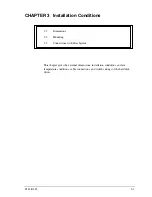
CHAPTER 5 SERVO ADJUSTMENT
5-8
Easy Tuning
5
Results of easy tuning
After easy tuning is normally finished, the gain and load inertia ratio automatically adjusted in
tuning are reflected on parameters. (See the table below.)
If resonance is observed during easy tuning, a notch filter is automatically set to suppress
resonance, and the filter is reflected on parameters.
Perform regular operation under the above status and if satisfactory actions are obtained, there is
no need to perform tuning described on following pages.
<Parameters set with the easy tuning function>
Number: PA1_
Name
14
Load inertia ratio
51
Moving average S-curve time
54
Position command response time constant
55
Position loop gain 1
56
Speed loop gain 1
57
Speed loop integration time constant 1
87
Model torque filter time constant
88
Position loop integration time constant
Notes on easy tuning
With easy tuning, automatic operation is performed according to functions of the servo amplifier.
Sufficient care should be taken on the safety.
If ill effects are expected to the machine due to resonance of the motor with the mechanical
system, assign the servo-on (S-ON) signal to a CONT signal before starting easy tuning.
If a fault is found during operation, turn the signal off immediately.
If the excessive stroke cause damage to the machine, assign ± over-travel (±OT) signals to CONT
signals and install over-travel sensors at both ends of the motion stroke before starting easy
tuning.
Easy tuning for vertical transportation
When performing easy tuning with the servomotor for vertical transportation, to prevent a carried
object from falling due to its own weight, turn the servo-on signal to ON and check that the servo
lock is activated before releasing the brake.
Then performe easy tuning, refer to P5-6 procedure.
Summary of Contents for ALPHA 5 RYT-SX
Page 1: ...MEHT301a FUJI SERVO SYSTEM USER S MANUAL RYT SX type ...
Page 19: ...0 1 CHAPTER 0 INTRODUCTION 0 ...
Page 34: ...CHAPTER 0 INTRODUCTION 0 16 Combination between Servomotor and Servo Amplifier 0 ...
Page 35: ...1 1 CHAPTER 1 INSTALLATION 1 ...
Page 45: ...2 1 CHAPTER 2 WIRING 2 ...
Page 142: ...CHAPTER 2 WIRING 2 98 Description of I O Signals 2 ...
Page 143: ...3 1 CHAPTER 3 OPERATION 3 ...
Page 197: ...4 1 CHAPTER 4 PARAMETER 4 ...
Page 296: ...CHAPTER 4 PARAMETER 4 100 Output Terminal Function Setting Parameters 4 ...
Page 297: ...5 1 CHAPTER 5 SERVO ADJUSTMENT 5 ...
Page 329: ...6 1 CHAPTER 6 KEYPAD 6 ...
Page 371: ...7 1 CHAPTER 7 MAINTENANCE AND INSPECTION 7 ...
Page 389: ...8 1 CHAPTER 8 SPECIFICATIONS 8 ...
Page 414: ...CHAPTER 8 SPECIFICATIONS 8 26 Dimensions of Servo Amplifier 8 ...
Page 415: ...9 1 CHAPTER 9 CHARACTERISTICS 9 ...
Page 425: ...10 1 CHAPTER 10 PERIPHERAL EQUIPMENT 10 ...
Page 463: ...11 1 CHAPTER 11 ABSOLUTE POSITION SYSTEM 11 ...
Page 473: ...12 1 CHAPTER 12 POSITIONING DATA 12 ...
Page 482: ...CHAPTER 12 POSITIONING DATA 12 10 Response Time 12 ...
Page 483: ...13 1 CHAPTER 13 PC LOADER 13 ...
Page 513: ...14 1 CHAPTER 14 APPENDIXES 14 ...
Page 545: ...CHAPTER 14 APPENDIXES Service Network 14 33 14 14 8 Service Network ...
Page 546: ...CHAPTER 14 APPENDIXES 14 34 Service Network 14 ...
















































